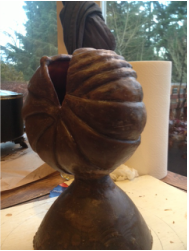
I would say about 80% of cast glass is open faced molds. Why? Because open faced molds are easy since you can use clay to sculpt with, then pull out the clay and you have a mold to fill with glass. Open faced molds you can see everything, so if you need to repair a flaw in the refractory; you are able to do so.
In closed faced molds, wax is the medium being invested and steamed out. The wax is much more complex to work with. The process is blind since you have no way of knowing what the refractory looks like after the wax is steamed out.
How could a person tell if the glass is cast in an open or closed face mold? With open faced molds, one side of the sculptural piece will be flat, however the detailed side is photographed. This can cause grief to any glass artist that casts using the "lost wax method" or closed molds. Sometimes the work of the full 3D sculpture doesn't reveal itself in a photo and uninformed folks are inclined to believe the open faced mold artist may be more skilled.
Taken from the Bullseye website:
You can kilncast glass into two kinds of molds: open-faced or closed/semi-closed. In open-faced molds, one side of the mold is completely open; the cold glass is placed directly into the mold through that opening. Using open-faced molds, you can create reverse-relief, bas-relief, pâte de verre, thick-block, and box castings. In molds that are closed/semi-closed, the mold is open only wide enough to allow the glass to flow in from the outside, often through a reservoir. Using closed/semi-closed molds, you can make fully sculptural pieces.
Pictured above is a wax sculpture, almost ready for investment. The cone shaped base is the reservoir for glass. The opening for the sculpture to receive the glass from the reservoir is the size of silver-dollar. Before the piece is invested in refractory, vents with wax sprues/ wooden skewers are placed all over the form in strategic places for proper glass movement, and to capture air bubbles.
In closed faced molds, wax is the medium being invested and steamed out. The wax is much more complex to work with. The process is blind since you have no way of knowing what the refractory looks like after the wax is steamed out.
How could a person tell if the glass is cast in an open or closed face mold? With open faced molds, one side of the sculptural piece will be flat, however the detailed side is photographed. This can cause grief to any glass artist that casts using the "lost wax method" or closed molds. Sometimes the work of the full 3D sculpture doesn't reveal itself in a photo and uninformed folks are inclined to believe the open faced mold artist may be more skilled.
Taken from the Bullseye website:
You can kilncast glass into two kinds of molds: open-faced or closed/semi-closed. In open-faced molds, one side of the mold is completely open; the cold glass is placed directly into the mold through that opening. Using open-faced molds, you can create reverse-relief, bas-relief, pâte de verre, thick-block, and box castings. In molds that are closed/semi-closed, the mold is open only wide enough to allow the glass to flow in from the outside, often through a reservoir. Using closed/semi-closed molds, you can make fully sculptural pieces.
Pictured above is a wax sculpture, almost ready for investment. The cone shaped base is the reservoir for glass. The opening for the sculpture to receive the glass from the reservoir is the size of silver-dollar. Before the piece is invested in refractory, vents with wax sprues/ wooden skewers are placed all over the form in strategic places for proper glass movement, and to capture air bubbles.
 RSS Feed
RSS Feed
